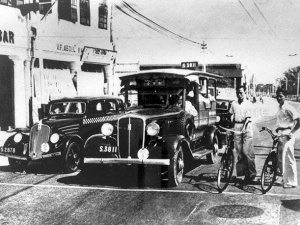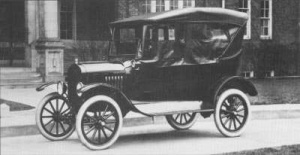'Mosquito' buses in Singapore (1920s-1930s)
The ‘Mosquito’ bus was a Ford Model T car chassis that had been converted into a small 7-seater omnibus. Its name was derived from its small size and the way it weaved in and out of traffic at high speed.[1] Throughout the 1920s and 1930s, mosquito buses were recognised as the pioneers of Singapore’s modern motor transport system.[2] These buses experienced a decline in popularity by the late 1930s. With stringent regulations, the cessation of the Ford Model T production in 1927 and the Second World War, mosquito buses were eventually phased out to give way to larger buses in the 1940s.[3][4]
History
Origin
The origin of mosquito buses can be traced back to local Chinese farmers. Previously, these farmers used bullock carts or hand carts to transport their produce from Choa Chu Kang, Yio Chu Kang and other remote areas of Singapore to the city centre. With the introduction of motor cars, several farmers decided to mount a 7 to 8 seater passenger body onto a car engine. This innovation brought about the phenomenon of Mosquito buses in Singapore.[5]
Mosquito buses were first used as a mode of transport that linked rural areas to the city. Widely favoured by the working classes, mosquito buses earned a reputation as the cheapest and fastest possible form of transport during the 1920s and 30s. Gradually, mosquito buses were able to expand their operations and began serving routes within the city.[6]
By 1923, larger buses were momentarily phased out as they were unable to compete against the popularity of the mosquito bus.[7]
Services and popularity
The mosquito buses were largely remembered for their speed and competition between owners. They had no fixed ‘bus-stops’ or pick-ups and often carried more passengers, animals and cargo than intended. The bus services were mostly described as ‘erratic’ - they only stopped when a passenger signalled, frequently turned around to pick up fares, competed with other owners to be the first to arrive and pick up passengers and drove at excessive speed to overtake other vehicles.[8]
Nevertheless, cheap fares and fast services contributed to the buses' popularity and their useful role in Singapore’s transport industry. The mosquito buses mainly operated on four routes: Tanjong Pagar - Geylang, Pasir Panjang, Serangoon - Paya Lebar and Bukit Timah.[9]
As a measure of its popularity, it was reported that the number of functioning Ford Model T vehicles in Singapore rose from 147 in 1921 to 456 in 1929.[10] Moreover, in 1933, 455 licences owned by about 300 individuals were reportedly granted to mosquito buses.[11]
Regulations
The mosquito buses were consistently subjected to various regulations and penalties by the Registrar of Vehicles (ROV). Recognising the dangers posed by the mosquito buses, the ROV introduced new regulations and penalties in 1927.
Firstly, buses were made to carry direction boards to indicate the routes they were servicing. Secondly, their speed was limited to 20 miles per hour to ensure the safety of passengers and drivers. Finally, buses were inspected 4 times a year when their licences were renewed, with special examinations carried out on buses that had a shabby appearance while on the road.[12] However, these regulations were weakly enforced and easily evaded by the bus owners.[13]
Decline
In 1933, the ROV served all motor bus owners with notices stating that by 1 July 1933, they would no longer license any Model T buses. This move was meant to gradually eliminate the Model T buses over a period of two years. In turn, they aimed to replace these buses with modern vehicles of larger capacity.[14] The ROV also urged the bus owners to restructure their businesses into bigger companies.[15] In 1935, after repeated pressure, these operators amalgamated into 11 Chinese bus companies with 144 buses between them. Collectively, they were known as the ‘Chinese bus companies’.[16]
While the success of these regulations was largely unreported, it should be noted that the Japanese Occupation of Singapore intervened before any of the ROV’s main objectives could be realised.[17]
References / Citations
- ↑ Fwa Tien Feng. Fifty Years of Transportation in Singapore: Achievements and Challenges. 2016. Accessed 18 July 2019.
- ↑ “Singapore transport problem”. The Singapore Free Press and Mercantile Advertiser. March 1, 1993. Accessed 18 July 2019. Retrieved from NewspaperSG
- ↑ “22,000,000 Fords Sold”. The Straits Times. October 25, 1934. Accessed 18 July 2019. Retrieved from NewspaperSG.
- ↑ Peter J. Rimmer. Rikisha to Rapid Transit: Urban Public Transport System and Policy in Southeast Asia. 1986. Accessed 18 July 2019
- ↑ Betty L. Khoo. “Singapore’s first power station”. New Nation. November 17, 1972. Accessed 18 July 2019. Retrieved from NewspaperSG
- ↑ “Romance of mosquito bus service”. The Straits Times. July 5, 1934. Accessed 18 July 2019. Retrieved from NewspaperSG.
- ↑ Peter J. Rimmer. Rikisha to Rapid Transit: Urban Public Transport System and Policy in Southeast Asia. 1986. Accessed 18 July 2019.
- ↑ “Singapore transport problem”. The Singapore Free Press and Mercantile Advertiser. March 1, 1933. Accessed 18 July 2019. Retrieved from NewspaperSG
- ↑ “Singapore transport problem”. The Singapore Free Press and Mercantile Advertiser. March 1, 1933. Accessed 18 July 2019. Retrieved from NewspaperSG
- ↑ “A half-century of Ford Cars”. The Singapore Free Press. September 27, 1957. Accessed 18 July 2019. Retrieved from NewspaperSG.
- ↑ “Singapore transport problem”. The Singapore Free Press and Mercantile Advertiser. March 1, 1933. Accessed 18 July 2019. Retrieved from NewspaperSG
- ↑ “Mosquito Buses”. The Straits Times. December 20, 1927. Accessed 18 July 2019. Retrieved from NewspaperSG
- ↑ Fwa Tien Feng. Fifty Years of Transportation in Singapore: Achievements and Challenges. 2016. Accessed 18 July 2019.
- ↑ “T Model motor buses to go”. The Straits Times. April 29, 1933. Accessed 18 July 2019. Retrieved from NewspaperSG.
- ↑ Peter J. Rimmer. Rikisha to Rapid Transit: Urban Public Transport System and Policy in Southeast Asia. 1986. Accessed 18 July 2019
- ↑ Peter J. Rimmer. Rikisha to Rapid Transit: Urban Public Transport System and Policy in Southeast Asia. 1986. Accessed 18 July 2019
- ↑ Peter J. Rimmer. Rikisha to Rapid Transit: Urban Public Transport System and Policy in Southeast Asia. 1986. Accessed 18 July 2019

